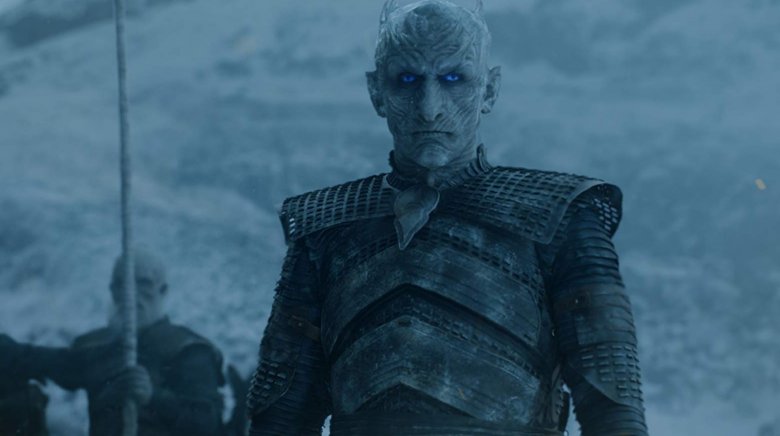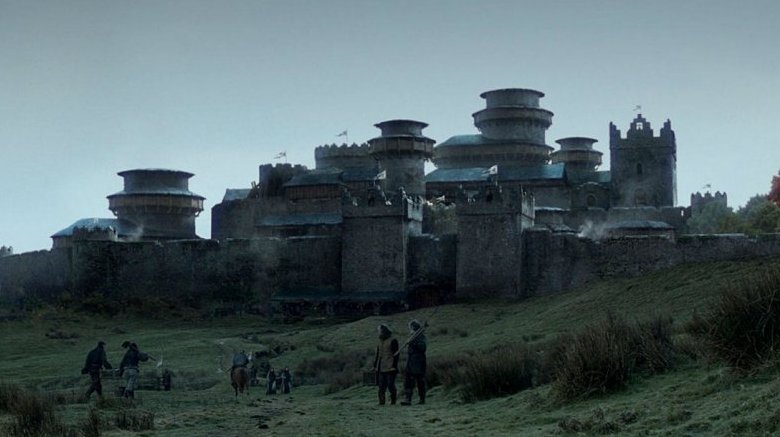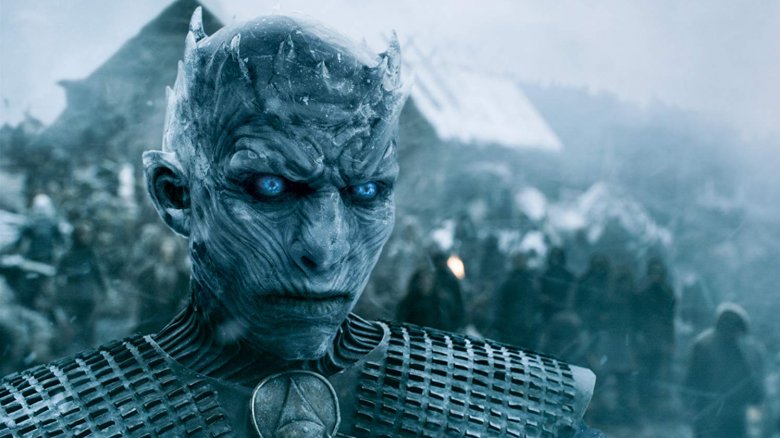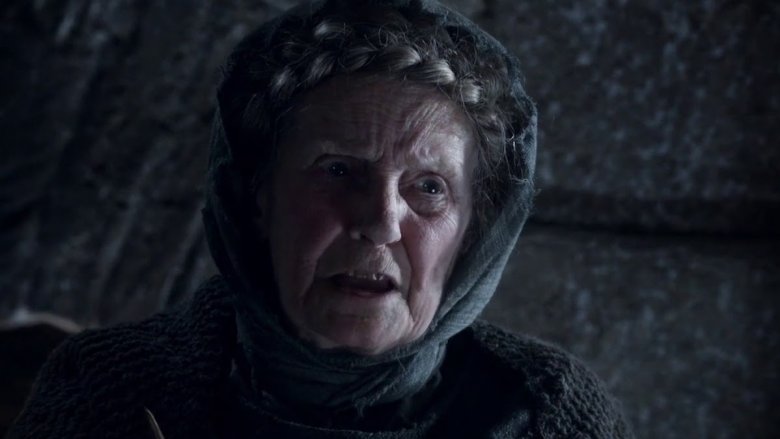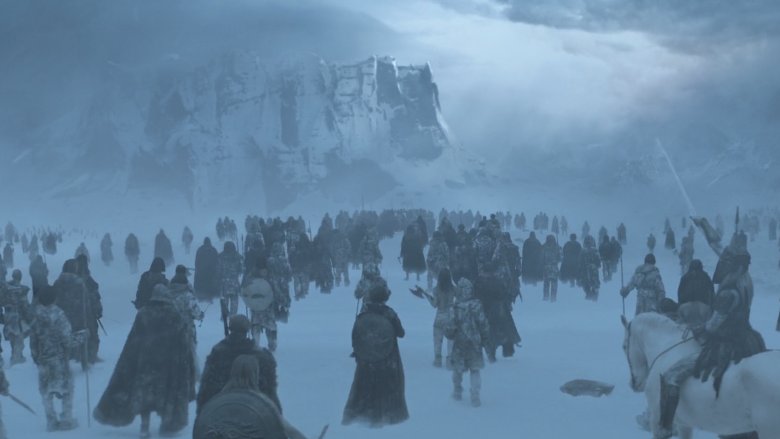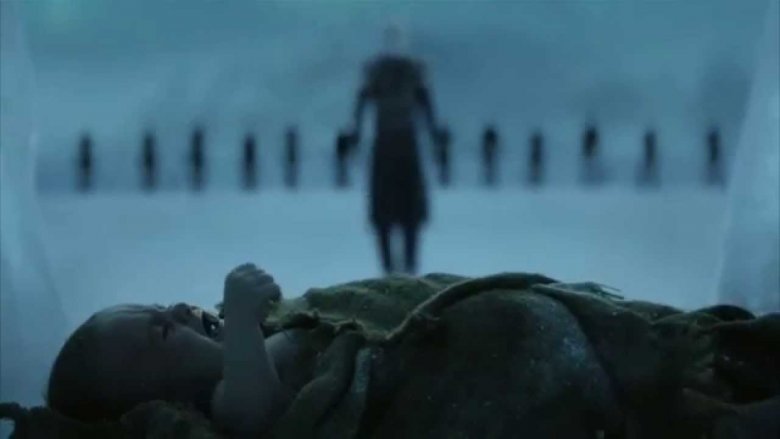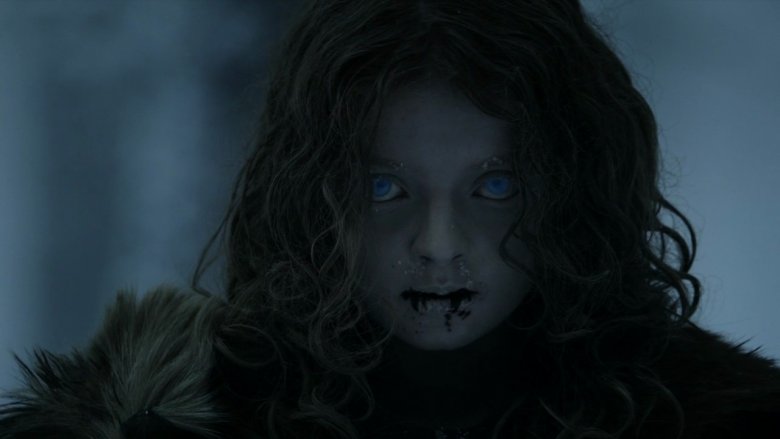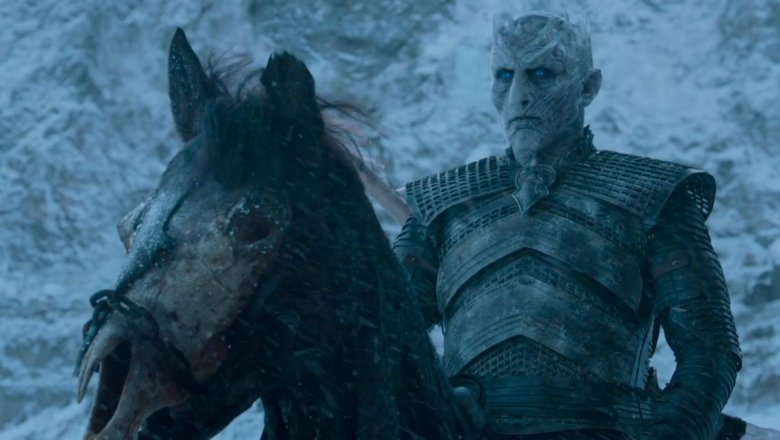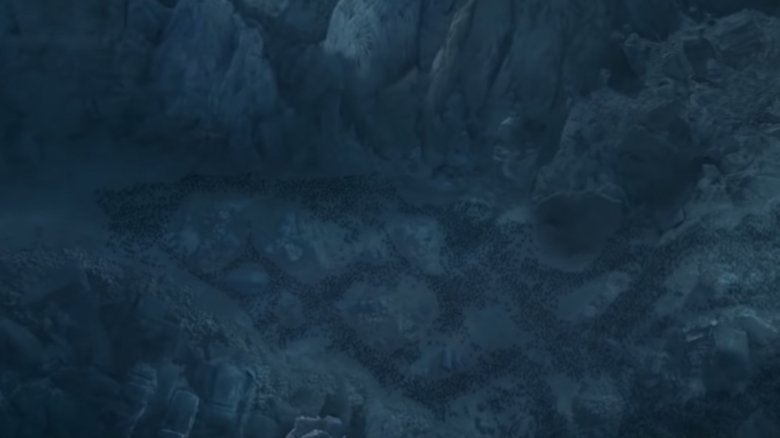Why The Night King In Game Of Thrones Is Almost Definitely A Stark
The world of Game of Thrones is full of twists and turns that have left audiences on the edge of their seats since the beginning. The world of Westeros is populated with complex characters, complicated family trees, and extensive lore that can make even the strangest of surprises seem plausible.
For the majority of the series, most of the major characters have concerned themselves with the politics and war surrounding the Iron Throne. However, the true threat looming over Westeros has nothing to do with the ongoing game of thrones at all. Instead, the true danger is the terrifying Night King and his army of the undead who march ever closer. While the Night King is a horrifying villain, he may have a connection to one of Westeros' most noble houses, House Stark. Based on clues in both the books and the television series, there are plenty of hints that could indicate that the Night King is actually a Stark.
The beginning of House Stark
To understand the connection between House Stark and the leader of the Others (or White Walkers), it's important to understand the beginnings of each. According to The World of Ice and Fire, the Long Night was a winter that lasted for an entire generation, thousands of years before the show and book series takes place. During the Long Night, the Others terrorized the First Men, the humans who had settled in Westeros. After much fighting with the Others, one of the First Men reached an agreement with the Children of the Forest and joined forces with them to repel the Others.
No one knows for certain who that person was. Some call them the Last Hero, while others refer to them as Azor Ahai. Whatever title is given, there are a few clues that hint that the first Stark, Bran the Builder, may have repelled the White Walkers. Bran would go on to work with the Children to build the Wall along with Storm's End, Winterfell, and Hightower.
So, Bran the Builder possibly defeated the White Walkers, built the fortress of the Kings of Winter (who would later come to be known as House Stark after Aegon's Conquest united Westeros into the Seven Kingdoms), and managed to put magical protections into place to help defend against the Others. Though this was the first interaction between the Starks and the Others, this would be far from the last or most significant.
The Night King vs. The Night's King
There is an important distinction that must be made between two key figures: the Night King and the Night's King. The Night King is the leader of the White Walkers in the Game of Thrones HBO series. The Night's King, however, is a figure briefly touched upon in the Song of Ice and Fire book series.
He was the 13th Lord Commander of the Night's Watch (for reference, Jon Snow is elected to be the 998th Lord Commander, according to A Feast for Crows). During his command, he fell in love with a mysterious woman, and together they began making human sacrifices to the Others. After 13 years, Brandon the Breaker of House Stark killed the Lord Commander and his wife.
The similar names have led some to speculate that the two may be the same person. However, when asked about the possibility of the Night's King surviving to be the Night King, George R.R. Martin explained in a LiveJournal post, "As for the Night's King... in the books he is a legendary figure, akin to Lann the Clever and Brandon the Builder, and no more likely to have survived to the present day than they have."
Even though they are different people, there is a deeper connection to be found here.
Old Nan confirms Night's King was a Stark
The official histories of the Seven Kingdoms, as represented in The World of Ice and Fire, speculate that the Night's King likely came from one of the Northern families, saying he could have been "...a Bolton, a Woodfoot, an Umber, a Flint, a Norrey, or even a Stark, depending on where the tale is told."
But when Old Nan told the story to Bran, as he recalls in A Storm of Swords, she said, "Some say he was a Bolton. Some say a Magnar out of Skagos, some say Umber, Flint, or Norrey. Some would have you think he was a Woodfoot, from them who ruled Bear Island before the ironmen came. He never was. He was a Stark, the brother of the man who brought him down."
The suggestion that the Night's King was the brother of the Lord of Winterfell certainly has a significant impact on the current Night King's relationship to the Starks of our story.
The Night's Queen
So, who is the mysterious woman who so quickly won the heart of the Lord Commander of the Night's Watch? Her exact identity is not known, but the few things that are stated about her raise some interesting questions.
The Lord Commander saw this woman from atop the Wall. In A Storm of Swords, she is said to have "skin as white as the moon and eyes like blue stars." This could simply be a fair-skinned woman with blue eyes. However, further claims about this woman bring her very humanity into question. Legend says that "her skin was cold as ice," leading some fans to speculate that she may have been one of the Others, with their cold, dead skin and glowing blue eyes.
But physical resemblance to the White Walkers aside, when Bran tells the story in A Storm of Swords, he indicates that "when he gave his seed to her, he gave his soul as well."
In The World of Ice and Fire, maesters appear to have mundane explanations for this woman's origins, writing, "Some suggest that perhaps the corpse queen was a woman of the Barrowlands, a daughter of the Barrow King who was then a power in his own right, and oft associated with graves."
With all of these clues gathered together, many have come come to believe that this woman was one of the White Walkers herself.
A half-human child raised as a Stark
One of the most heinous taboos in the world of Westeros is kin-slaying. The murder of one's own flesh and blood is one of the worst things a person can possibly do. The justification for such an act would have to be very well-founded to save the perpetrator from utter condemnation.
While killing a brother may be an obstacle for most Lords of Winterfell, Brandon the Breaker did not face that particular issue when taking on the 13th Lord Commander of the Night's Watch. However, that is not to say that taboos about kin-slaying were completely ignored by the surviving Stark.
It is entirely possible that the Night's Queen gave birth to a child. With the child's mother and father executed for their crimes of human sacrifice, it seems plausible that the child could have been spared by Brandon. Since the child was kin and half Stark, it is even possible that the child was raised at Winterfell as either a Stark or a Snow, similar to Jon. This could mean that the blood of the Others was introduced to the Stark line from very early on in the family's history.
Half-White Walker children confirmed by Old Nan
The Starks aren't the only ones who are said to have conceived half-human children with the White Walkers. In A Song of Ice and Fire, Bran remembers Old Nan telling stories about wildling women who, among other shameful deeds, "lay with the Others in the Long Night to sire terrible half-human children." Jon later corroborates this in a discussion with Commander Mormont. If Old Nan's stories are to be believed, the Night King's child could have been a product of the union between a human and White Walker. It is not completely implausible that the Starks have Other blood in their veins that was introduced to the family's line in the North by the Night's King.
With this in mind, the child born by the Night's Queen and Night's King and taken in by the Stark family would pass down Other blood to later generations of Stark children.
History erases tales of the Night's King
No one knows exactly who the Night's King was. All that is known about him is that he was the Lord Commander of the Night's Watch during its early years. This was not an accident of history, though — after killing the Night's King, Bran the Breaker had all references to the 13th Lord Commander's identity erased from written records.
This is a huge red flag. It is common for historians in A Song of Ice and Fire to have information missing from their accounts. There are many instances throughout the series where information is just missing from historical records.
Other times, information is left out for largely benign reasons. For example, in The World of Ice and Fire, the maester writing about the history of the Children of the Forest mentions Bran the Builder learning the Children's language so he could work with them to end the Long Night. Rather than explain about how this happened, he writes that this "is a tale in itself, and not worth repeating here."
The Starks are made for the cold
Throughout the series, the Starks are associated with the cold and ice. Winterfell is located in the far North, where the cold is brutal and unforgiving. For the Starks, though, this vast expanse of frequently frigid fields, hills, and villages is what they readily call home.
In the books, the Starks' love of the cold is blatant. Catelyn Stark remarks of her husband in A Song of Ice and Fire, "Ned would never abide by the heat. The Starks were made for the cold." Later in the book, Littlefinger makes a playful jab at Ned Stark, saying, "Here in the south, they say you are all made of ice, and melt when you ride below the Neck." The Starks have such a deep-rooted affinity for all things winter that their house's Valyrian steel greatsword is called Ice. Even the words of the house allude to the cold, reminding all who hear that "Winter is coming."
If the Starks have white walker blood in them, it could go a ways in explaining the Starks' connection to Winter and, to a larger extent, the Others.
Themes of complicated legacies
A common theme in Game of Thrones is the burden placed on characters by their ancestors. This is apparent for a large amount of the denizens of Westeros. Daenerys lives in the shadow of her father, the Mad King, and his terrible actions. She doesn't want to become a tyrant like her father, whose murderous rage led to his fall and the near-destruction of House Targaryen. Tyrion tries to prove his worth to his father, but ultimately has to come to terms with his disapproval.
If the Night King is a Stark, the members of House Stark will have to deal with the fallout of this revelation. This is especially true with Jon Snow, whose bloodline runs both Stark and Targaryen, already making him a character with a conflicted lineage.
A popular fan theory is that Jon Snow is the reincarnation of Azor Ahai, the "Last Hero" who defeated the White Walkers when they first came to Westeros. Some believe that Azor Ahai could very well have been Brandon "The Builder" Stark, leading to even further complications in the Stark family tree. It doesn't seem outside the realm of possibility that the added conflicted of White Walker blood would be thrust onto Jon Snow as well.
The Army of the Dead forms the Stark sigil
The seventh season finale, "The Dragon and the Wolf," ends on an ominous note, as the White Walkers break through the Wall and march into Westeros. During the scene, the camera shows a bird's eye view of the Army of the Dead marching forward. What's interesting about this shot is that the White Walkers march in a formation that appears highly reminiscent of the Starks' house sigil. The direwolf-esque formation slightly deviates from the Stark sigil in that the image is flipped, but the resemblance is otherwise uncanny. The inclusion of this shot is almost certainly a purposeful choice by the showrunners to indicate some sort of connection between the Stark House and the White Walkers — and by extension, the Night King.
Were the soldiers of the dead marching under an ancient Stark banner? Were they forming the sigil of their enemy for other purposes? What exactly this connection is will hopefully be answered in Game of Thrones' final season.
